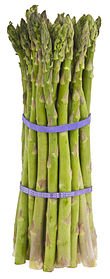Asparagus

Asparagus, or garden asparagus, folk name sparrow grass, scientific name Asparagus officinalis, is a perennial flowering plant species in the genus Asparagus. Its young shoots are used as a spring vegetable.
It was once classified in the lily family, like the related Allium species, onions and garlic. However, genetic research places lilies, Allium, and asparagus in three separate families—the Liliaceae, Amaryllidaceae, and Asparagaceae, respectively—with the Amaryllidaceae and Asparagaceae being grouped together in the order Asparagales. Sources differ as to the native range of Asparagus officinalis, but generally include most of Europe and western temperate Asia.[3][4][5][6] It is widely cultivated as a vegetable crop.
Asparagus is a herbaceous, perennial plant[7] growing to 100–150 cm (40–60 in) tall, with stout stems with much-branched, feathery foliage. The “leaves” are in fact needle-like cladodes (modified stems) in the axils of scale leaves; they are 6–32 mm (1⁄4–1 1⁄4 in) long and 1 mm (1⁄32 in) broad, and clustered four to 15 together, in a rose-like shape.[8] The root system, often referred to as a “crown,” is adventitious and the root type is fasciculated. The flowers are bell-shaped, greenish-white to yellowish, 4.5–6.5 mm (3⁄16–1⁄4 in) long, with six tepals partially fused together at the base; they are produced singly or in clusters of two or three in the junctions of the branchlets. It is usually dioecious, with male and female flowers on separate plants, but sometimes hermaphrodite flowers are found. The fruit is a small red berry 6–10 mm (1⁄4–13⁄32 in) in diameter, which is toxic to humans.[9]
Plants native to the western coasts of Europe (from northern Spain to northwest Germany, north Ireland, and Great Britain) are treated as Asparagus officinalis subsp. prostratus (Dumort.) Corb., distinguished by its low-growing, often prostrate stems growing to only 30–70 cm (12–28 in) high, and shorter cladodes 2–18 mm (3⁄32–23⁄32 in) long.[4][10] It is treated as a distinct species, Asparagus prostratus Dumort, by some authors.[11][12]
